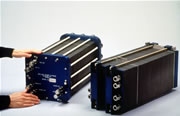
![]()
A fuel cell converts the chemical energy in hydrogen and oxygen into direct current electrical energy by electrochemical reactions. Fuel cells are devices that convert hydrogen gas directly into low-voltage, direct current electricity. The cell has no moving parts.
 |
| 13kW PEM fuel cell (Photo: Ballard Power Systems, Inc.) |
|---|
The process is essentially the reverse of the electrolytic method of splitting water into hydrogen and oxygen. In the fuel cell, the cathode terminal is positively charged and the anode terminal is negatively charged. These electrodes are separated by a membrane. Hydrogen gas is converted into electrons and protons (positive hydrogen ions) at the anode. The protons pass through the membrane to the cathode, leaving behind negatively charged electrons. This creates a flow of direct current electricity between the terminals when connected with an external circuit. This current can power an electric motor placed in this circuit. The hydrogen ions, electrons, and oxygen combine at the cathode to form water, the only byproduct of the process.
The key element in a fuel cell is the ion (proton) exchange membrane. Its purpose is to separate the anode and cathode to prevent mixing of the fuel and oxidant and to provide an ionically conductive pathway for protons. Thus, its required properties are high ionic conductivity (and zero electronic conductivity) under cell operating conditions, long term chemical and mechanical stability at elevated temperatures in oxidizing and reducing environments, good mechanical strength with resistance to swelling, low oxidant and fuel crossover, pinhole free structure, interfacial compatibility with catalyst layers and low cost.
 |
| Honda FCX fuel cell vehicle, December 2002. (Photo: Ballard Power Systems, Inc.) |
|---|
Fuel cells have the potential for excellent efficiency and can convert up to 75 percent of the energy in the fuel. When a fuel cell is used in an automobile, the automotive power train must be converted to electricity. Fuel cells may also be used as a stationary power source supplying electricity for a utility company or electricity to individual consumers.
In automobiles, there are two major advantages of a fuel cell versus an internal combustion engine. The first is that the fuel cell is approximately twice as fuel-efficient (on a fuel-to-wheel basis). The second advantage is the next generation of automobiles may be electric-powered. Storing electricity for automotive use can only be done the by use of fuel cells. Battery technology cannot meet the weight, volume and range required for today’s automobile.
On the negative side, a fuel cell will cost $3,000 to $5,000 per kW compared to $50 per kW for an internal combustion engine. Thus, reducing a fuel cell’s cost is the major R&D challenge.
A fuel cell can operate on industrial waste hydrogen, hydrogen from propane, or methane generated at the waste-water treatment plants. Ultimately, hydrogen obtained from renewable resources such as solar, wind, or biomass energy will provide a sustainable and clean source of hydrogen for fuel cell power generation.
There are five types of fuel cells available:
Polymer Electrolyte Membrane Fuel Cell (PEMFC) - A PEMFC fuel cell employs a solid organic polymer polyperfluorsulfonic acid electrolyte membrane and operates at temperatures of 60-100° C. PEMFC applications include electric utilities, portable power, and transportation. Its main advantages are that the solid electrolyte reduces corrosion, operates at low temperatures, and delivers quick start-up. Its disadvantages are that the cell requires expensive catalysts and the cell has high sensitivity to fuel impurities.
Alkaline Fuel Cell (AFC) - An AFC employs an aqueous solution of potassium hydroxide soaked in a matrix electrolyte, and operates at temperatures of 90-100°C. AFC applications include military and space, and it is the technology that has been used by NASA for more than 25 years. Its main advantage is that cathode reaction is faster in the alkaline electrolyte, resulting in high performance. Its disadvantage is the requirement for pure hydrogen, requiring expensive CO2 removal from fuel and air streams.
 |
| European fuel cell bus project, June 2002 (Photo: Ballard Power Systems, Inc.) |
|---|
Phosphoric Acid Fuel Cell (PAFC) - A PAFC employs a matrix soaked with liquid phosphoric acid. It operates at temperatures of 175-200° C. PAFC applications include electric utility and transportation. Its main advantages are that it has up to 85% efficiency when used in cogeneration of electricity and heat, and it can use impure hydrogen as fuel. Its main disadvantages are that it requires a platinum catalyst, has low current and power, and requires a large size and weight.
Molten Carbonate Fuel Cell (MCFC) - An MCFC employs a liquid solution of lithium, sodium, and/or potassium carbonates soaked in a matrix. It operates at 600-1000° C. The main MCFC applications are for electric utilities. Its advantages are its high efficiency, fuel flexibility and its ability to use a variety of catalysts. Its disadvantage is that the high temperature enhances corrosion and breakdown of cell components.
Solid Oxide Fuel Cell (SOFC) - An SOFC employs a solid zirconium oxide to which a small amount of yttria is added. It operates at 600-1000° C. Its main advantages are its high efficiency, fuel flexibility, ability to use a variety of catalysts and reduced corrosion. Its main disadvantage is that the high temperature spurs breakdown of cell components. For transportation applications, the three key fuel cell challenges are cost (less than $50/kW of engine power), durability (at least 5,000 hours) and rapid start-up (less than 30 seconds).
For more information on fuel cells, see:
http://www.eere.energy.gov/hydrogenandfuelcells/ fuelcells/basics.html
